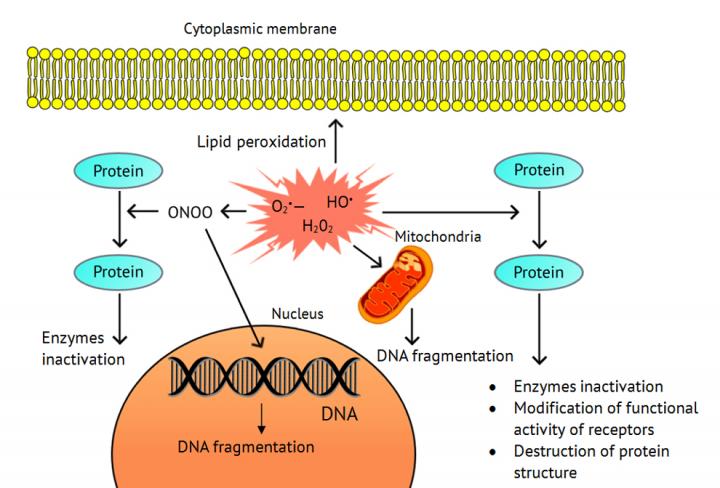RUDN biochemists found out how ROS affect cisplatin resistance in ovarian cancer cells

The mechanism of oxidative stress. Courtesy of Allen Dressen
RUDN biochemists studied the mechanism of drug resistance development in ovarian cancer cells under treatment with cisplatin. The researchers found out that the process was connected with increased expression (production of proteins coded by DNA molecules) of genes of key antioxidant enzymes (i.e. destroying ROS):
Mn-superoxide dismutase, catalase, glutathione peroxidase-1, hemoxygenase-1, as well as reduced expression of the enzyme NADPH-oxidase, which is responsible for ROS generation in the cell.
In the normal state there is a balance between the formation and destruction of ROS. Any changes in this balance may cause damage in the internal structure of the cells leading to number of diseases including cancer.
On the other hand, high concentrations of ROS may also lead to the death of cancer cells. This effect is used in cancer therapy, and cisplatin may operate on a similar principle.
In their work the scientists used the real time RT-PCR method and western blotting to evaluate gene expression.
The discovered redox-dependent mechanism of drug resistance development shows how well tumor cells can adapt to negative environmental conditions. The mechanism helps healthy cells survive, but in case of malignant tumors hinders their treatment.
“We found that under treatment of the ovarian cancer cells with cisplatin a new mechanism is triggered, changing the balance between generation and elimination of ROS; it is called as the adaptive antioxidant response.
The studied mechanism of drug resistance development would help create new combined methods for ovarian cancer treatment,” said Elena Kalinina, the author of the study, doctor of biological science, and professor of RUDN Institute of Medicine.
Media Contact
More Information:
http://dx.doi.org/10.1002/2211-5463.12453All latest news from the category: Life Sciences and Chemistry
Articles and reports from the Life Sciences and chemistry area deal with applied and basic research into modern biology, chemistry and human medicine.
Valuable information can be found on a range of life sciences fields including bacteriology, biochemistry, bionics, bioinformatics, biophysics, biotechnology, genetics, geobotany, human biology, marine biology, microbiology, molecular biology, cellular biology, zoology, bioinorganic chemistry, microchemistry and environmental chemistry.
Newest articles

Silicon Carbide Innovation Alliance to drive industrial-scale semiconductor work
Known for its ability to withstand extreme environments and high voltages, silicon carbide (SiC) is a semiconducting material made up of silicon and carbon atoms arranged into crystals that is…

New SPECT/CT technique shows impressive biomarker identification
…offers increased access for prostate cancer patients. A novel SPECT/CT acquisition method can accurately detect radiopharmaceutical biodistribution in a convenient manner for prostate cancer patients, opening the door for more…

How 3D printers can give robots a soft touch
Soft skin coverings and touch sensors have emerged as a promising feature for robots that are both safer and more intuitive for human interaction, but they are expensive and difficult…





















